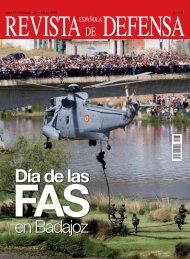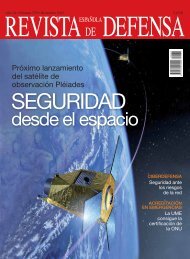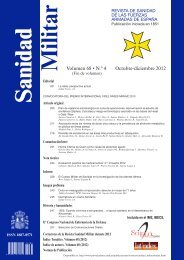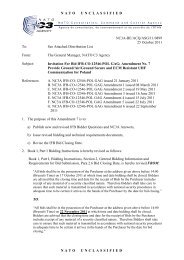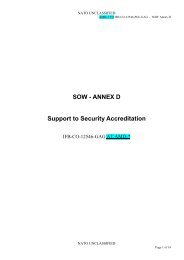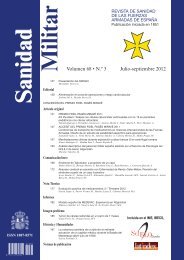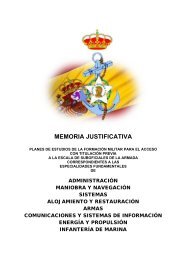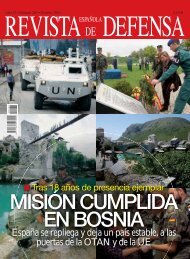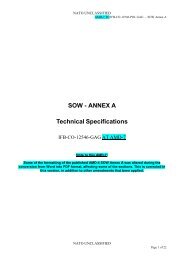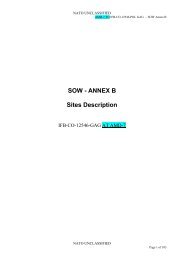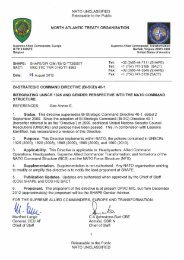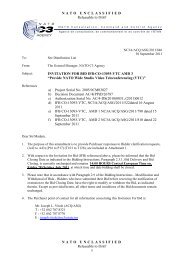Sanidad Militar - Ministerio de Defensa
Sanidad Militar - Ministerio de Defensa
Sanidad Militar - Ministerio de Defensa
Create successful ePaper yourself
Turn your PDF publications into a flip-book with our unique Google optimized e-Paper software.
Empleo <strong>de</strong> componentes sanguíneos, fármacos y procedimientos para el tratamiento <strong>de</strong> la hemorragia...7. Rossaint R, Bouillon B, Cerny V, Coats TJ, Duranteau J, Fernan<strong>de</strong>z-Mon<strong>de</strong>jarE, et al. Management of bleeding following major trauma: an updateEuropean gui<strong>de</strong>line. Critical Care 2010, 14:R52.8. Ellison N. Transfusion therapy. En: Zajtchuk R, Gran<strong>de</strong> CM. Anesthesia andperioperative care of the combat casualty. Washington: Textbook of militarymedicine; 1995. p. 321-39.9. Bolan CD, Webster NR. <strong>Militar</strong>y transfusion practice. En: Zajtchuk R,Gran<strong>de</strong> CM. Anesthesia and perioperative care of the combat casualty.Washington: Textbook of military medicine; 1995. p. 341-73.10. Shawn C, Lounsbury D, Hertz S. Acute resuscitation and critical care. EnShawn C, Lounsbury D, Hertz S. War Surgery in Afganistan and Iraq. 1ªed. Washington DC, Bor<strong>de</strong>n Institute, Walter Reed Army Medical Center;2008.p. 17-52.11. Miller RD, Robbins TO, Tong MJ, Barton SL. Coagulation <strong>de</strong>fects associatedwith massive blood transfusions. Ann Surg 1971; 174: 794–801.12. Borgman MA, et al. The ratio of blood products transfused affects mortalityin patients receiving massive transfusions at a combat support hospital. JTrauma. 2007; 63:805–13.13. Johansson PI, Ostrowski SR, Secher NH. Management of major blood loss:an update. Acta Anaesthesiol Scand 2010; 54 (9): 1039-49.14. Repine TB, Perkins JG, Kauvar DS, Blackborne L. The use of fresh wholeblood in massive transfusion. J Trauma 2006; 60 (6): S59-69.15. Hrezo RJ, Clark J. The walking blood bank: an alternative blood supply inmilitary mass casualties. Disaster Manag response 2003; 1(1):19-22.16. Spinella PC. Warm fresh whole blood transfusion for severe hemorrhage:U.S. military and potential civilian applications. Crit Care Med 2008; 36(7):S340-5.17. Spinella PC, Perkins JG, Grathwohl KW, Beekley AC, Holcomb JB. Warmfresh whole blood is in<strong>de</strong>pen<strong>de</strong>ntly associated with improved survival for patientswith combat-related traumatic injuries. J Trauma 2009; 66(4):S69-76.18. Kauvar DS, Holcomb JB, Norris GC, Hess JR. Fresh whole blood transfusion:a controversial military practice. J Trauma 2006; 61(1):181-4.19. Perkins JG, Cap AP, Spinella PC, Blackbourne LH, Grathwohl KW, RepineTB, et al. An evaluation of the impact of apheresis platelets used in the settingof massively transfused trauma patients. J Trauma 2009; 66(4):S77-84.20. Doughty A. Mission impossible? Blood for the battle space. WMMMG.Queen Elisabeth Hospital, Birmingham 13 Oct 2011.21. Mahoney PF. Images of anaesthesia. JR Army Med Corps. 2010; 156(4):407-12.22. Doughty HA, Woolley T, Thomas GOR. Massive transfusion. JR Army MedCorps. 2011; 157(3): 277-83.23. Expósito JL. Oro rojo para las operaciones. Revista Española <strong>de</strong> <strong>Defensa</strong>.2009; 250: 24-7.24. Lelkens CC, Koning JG, Kort B, Floot IB, Noorman F. Experiences withfrozen blood products in the Netherlands military. Transfus Apher Sci 2006;34 (3):289-98.25. Neuhaus SJ, Wishaw K, Lelkens C. Australian experience with frozen productson military operations. MJA 2010; 192 (4): 203-5.26. Norda R, Tynell E, Akenblom O. Cumulative risks of early fresh frozen plasma,cryoprecipitate and platelet transfusión in Europe. J Trauma 2006; 60(6): 41-5.27. Fox CJ, Gillespie DL, Cox ED, Mehta SG, Kragh JF, Salina J, HolcombJB. The effectiveness of a damage control resuscitation strategy for vascularinjury in a combat support hospital: results of a case control study. J Trauma2008; 64(2):99-106.28. Hiippala ST, Myllyla GJ, Vahtera EM. Hemostatic factors and replacementof major blood loss with plasma-poor red cell concentrates. Anesth Analg1995; 81 (2): 360–5.29. Stinger HK, Spinella PC, Perkins JG, Grathwohl KW, Salinas J, Martini WZ.The ratio of fibrinogen to red cells transfused affects survival in casualtiesreceiving massive transfusions at an Army Combat Support Hospital. J Trauma2008; 64 (2): S79-5.30. Samama CM. Prothrombin complex concentrates: a brief review. Eur JAnaesthesiol 2008; 25 (10): 784-9.31. Fries D, Innerhofer P, Schobersberger W. Time for changing coagulation managementin trauma-related massive bleeding. Curr Opin Anaesthesiol 2009;22 (2): 267-74.32. Sapsford W. The potential use of recombinant activated factor VII in traumaand surgery. Scand J Surg 2004; 93(1):17-23.33. Scher C, Narine V, Chien D. Recombinant factor VIIa in trauma patientswithout coagulation disor<strong>de</strong>rs. Anesthesiol Clin 2010; 28(4):681-90.34. Kenet G, Wal<strong>de</strong>n R, Eldad A, Martinowitz U. Treatment of traumatic bleedingwith recombinant factor VIIa. Lancet. 1999; 354(9193):1879.35. Perkins JG, Schreiber MA, Wa<strong>de</strong> CE, Holcomb JB. Early verus late recombinantfactor VIIa in combat trauma patients requiring massive transfusion.J Trauma 2007; 62(5):1095-9.36. Spinella PC, Perkins JG, McLaughlin DF, Niles SA, Grathwohl KW, BeekleyAC, et al. The effect of recombinant activated Factor VII on mortalityin combat-related casualties with severe trauma and massive transfusion. JTrauma 2008; 64 (2): 286-94.37. Boffard KD, Riou B, Warren B, Choong Pl, Rizoli S, Rossaint R, et al. Recombinantfactor VIIa as adjunctive therapy for bleeding control in severelyinjured trauma patients: two parallel randomized, placebo-controlled, double-blindclinical trials. J Trauma 2005; 59(1): 8-15.38. Lin Y, Stanworth S, Birchall J, Doree C, Hy<strong>de</strong> C. Recombinant factor VIIafor the prevention and treatment of bleeding in patients without haemophilia.Cochrane Database Sys Rev 2011; 16(2): CD005011.39. Davies E, Smith A, Mahoney P, Midwinter M. Activated recombinant factorseven in British <strong>Militar</strong>y Trauma: an audit of use against SGOPL gui<strong>de</strong>lines.JR Army Med Corps 2010; 156(3):17840. Hodgetts TJ, Kirkman E, Mahoney PF, Russell R, Thomas R, MidwinterM. UK <strong>de</strong>fence medical services guidance for the use of recombinant factorVIIA (RFVIIA) in the <strong>de</strong>ployed military setting. JR Army Med Corps 2007;153(4): 307-9.41. Koshy JC, Hollier LH. Review of primary fibrinolysis is integral in thepathogenesis of the acute coagulopathy of trauma. J Craniofac Sur 2011;22(5):1980.42. The CRASH2 Collaborators. Effects of tranexamic acid on <strong>de</strong>ath, vascularocclusive events, and blood transfusion in trauma patients with significant hemorrhage(CRASH2): a randomized, placebo-controlled trial. Lancet 2011;376 (9734):23-32.43. Morrison JJ, Dubose JJ, Rasmussen TE, Midwinter MJ. <strong>Militar</strong>y applicationof tranexamic acid in trauma emergency resuscitation (MATTERs) study.Arch Surg. En prensa 2011.44. Dawes R, Thomas GO. Battlefield resuscitation. Curr Opin Crit Care 2009;15(6):527-35.45. Deal VT, McDowell D, Benson P, Iddins B, Gluck G, Griffay A. et al. Tacticalcombat casualty care February 2010, direct from the battlefield: TCCClessons learned in Iraq and Afghanistan. J Spec Oper Med 2010:10(3); 77-119.46. Anónimo. Battlefield Advanced Trauma Life Support. J R Army Med Corps2004; 150(1): 32-40.47. Inspección General <strong>de</strong> <strong>Sanidad</strong>. Manual <strong>de</strong> asistencia al paciente crítico <strong>de</strong>las Fuerzas Armadas. Madrid. <strong>Ministerio</strong> <strong>de</strong> <strong>Defensa</strong>; 2009.48. Hodgetts TJ, Mahoney PF, Russell MQ, Byers M. ABC to ABC: re<strong>de</strong>finingthe military trauma paradigm. Emerg Med J 2006; 23 (10):745-6.49. González Alonso V, Cuadra Madrid ME, Usero Pérez MC, Colmenar JarilloG, Sánchez Gil MA. Control <strong>de</strong> la hemorragia externa en combate. PrehospEmerg Care 2009; 2(4): 293-304.50. Pozza M. Controllo <strong>de</strong>ll’emorragia massiva in ambiente extra ospedaliero.N&A mensile italiano <strong>de</strong>l soccorso. 2010; 209: 2-8.51. Lawton G, Granville-Chapman J, Parker PJ. Novel haemostatic dressings. JRArmy Med Corps 2009; 155(4): 309-14.52. Alam HB, Burris D, DaCorta JA, Rhee P. Hemorrhage control in the battlefield:role of new hemostatic agent. Mil Med 2005; 170(1): 63-9.53. Cooper BR. Intra-osseous access (EZ-IO) for resucitation: UK military combatexperience. J R Army Med Corp 2007; 153 (4):314-6.54. La sangre, en misiones <strong>de</strong> rescate, aumenta la tasa <strong>de</strong> supervivencia <strong>de</strong> los heridos.Revista Atenea. El observatorio. 20 diciembre <strong>de</strong> 2010. Nº 157. 14-15.55. Arnaud F, Tomori T, Carr W, McKeague A, Teranishi K, Prusaczyk K, etal. Exothermic reaction in zeolite hemostatic dressings: QuickClot ACS andACS+. Annals of Biomedical Engineering 2008; 36 (10):1708-13.56. Blackbourne LH. Combat damage control surgery. Crit Care Med 2008;36(7): 304-10.57. Sambasivan CN, Un<strong>de</strong>rwood SJ, Cho SD, Kiraly LN, Hamilton GJ, KofoedJT, et al. Comparison of abdominal damage control surgery in combat versuscivilian trauma. J Trauma 2010; 69 (1): S168-74.58. AJP-4.10(A) Allied Joint Medical Support Doctrine. NATO.Sanid. mil. 2013; 69 (2) 93



